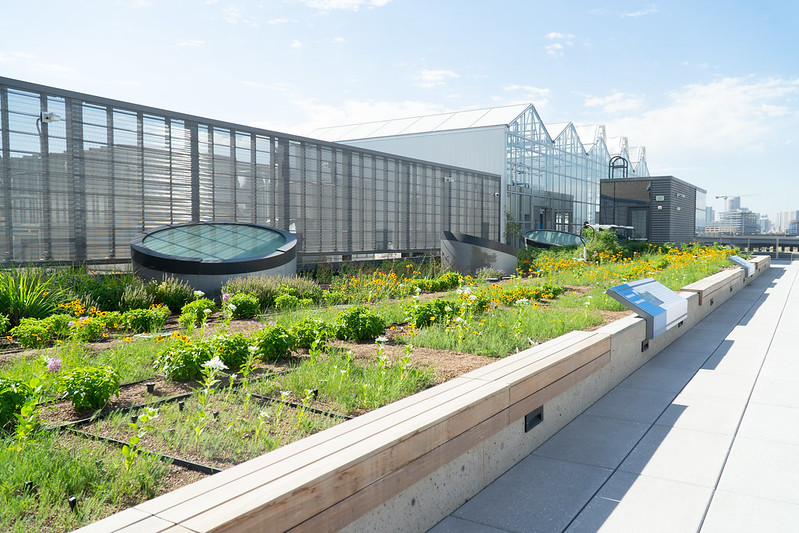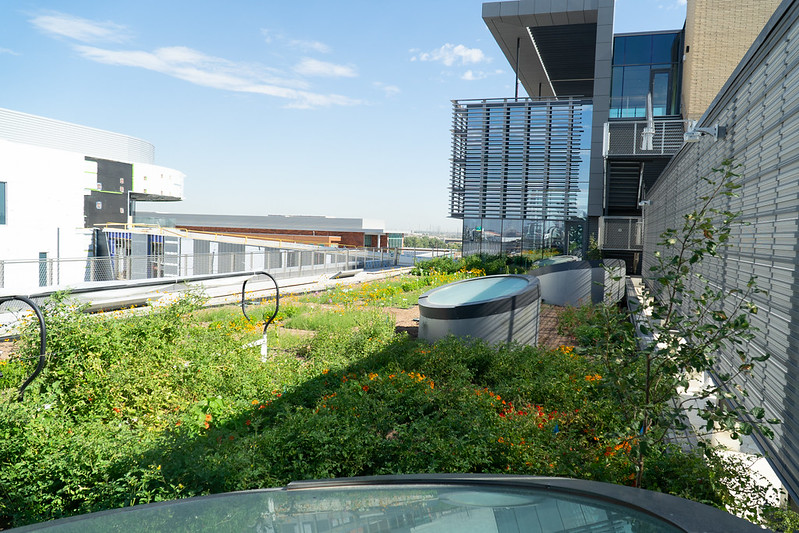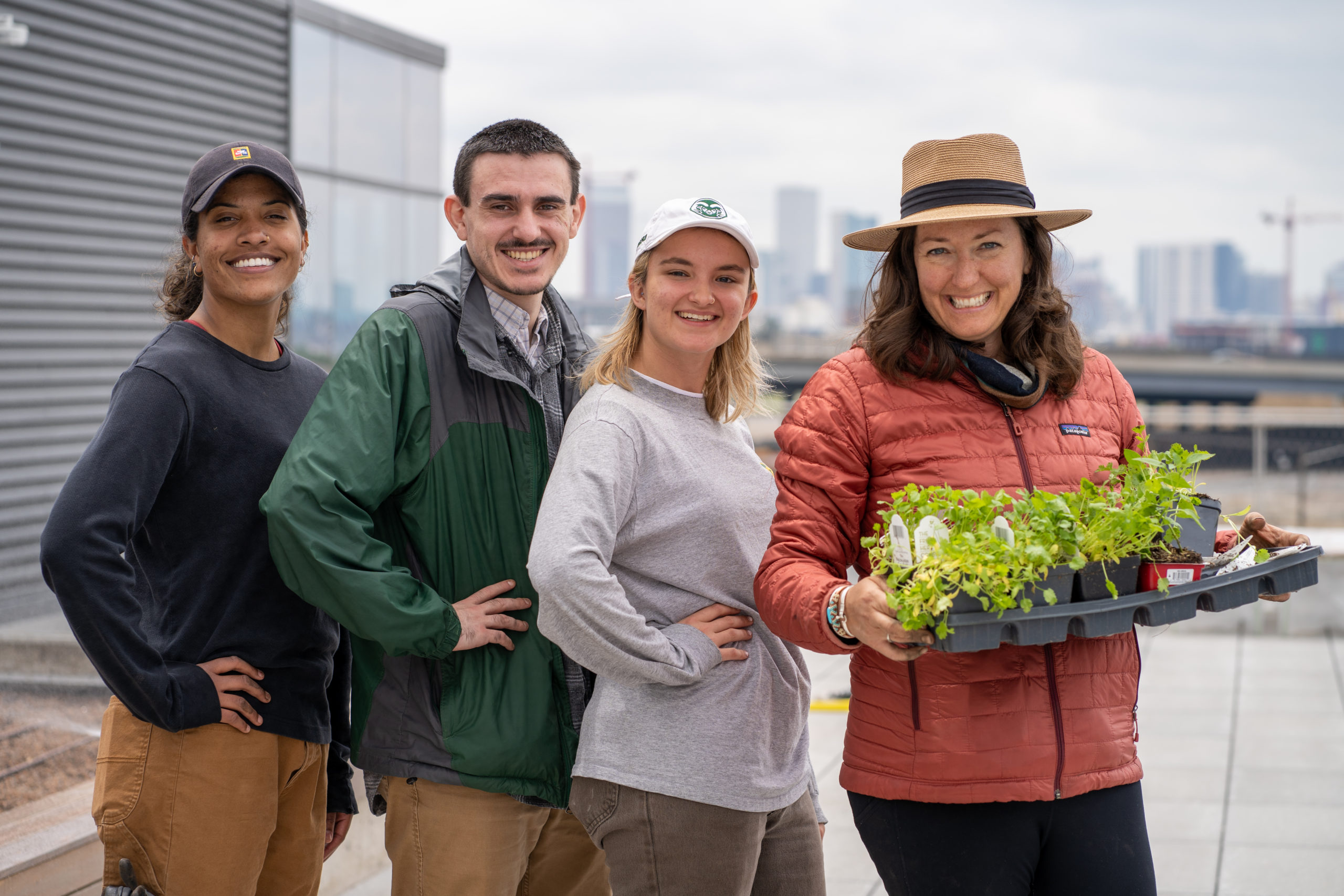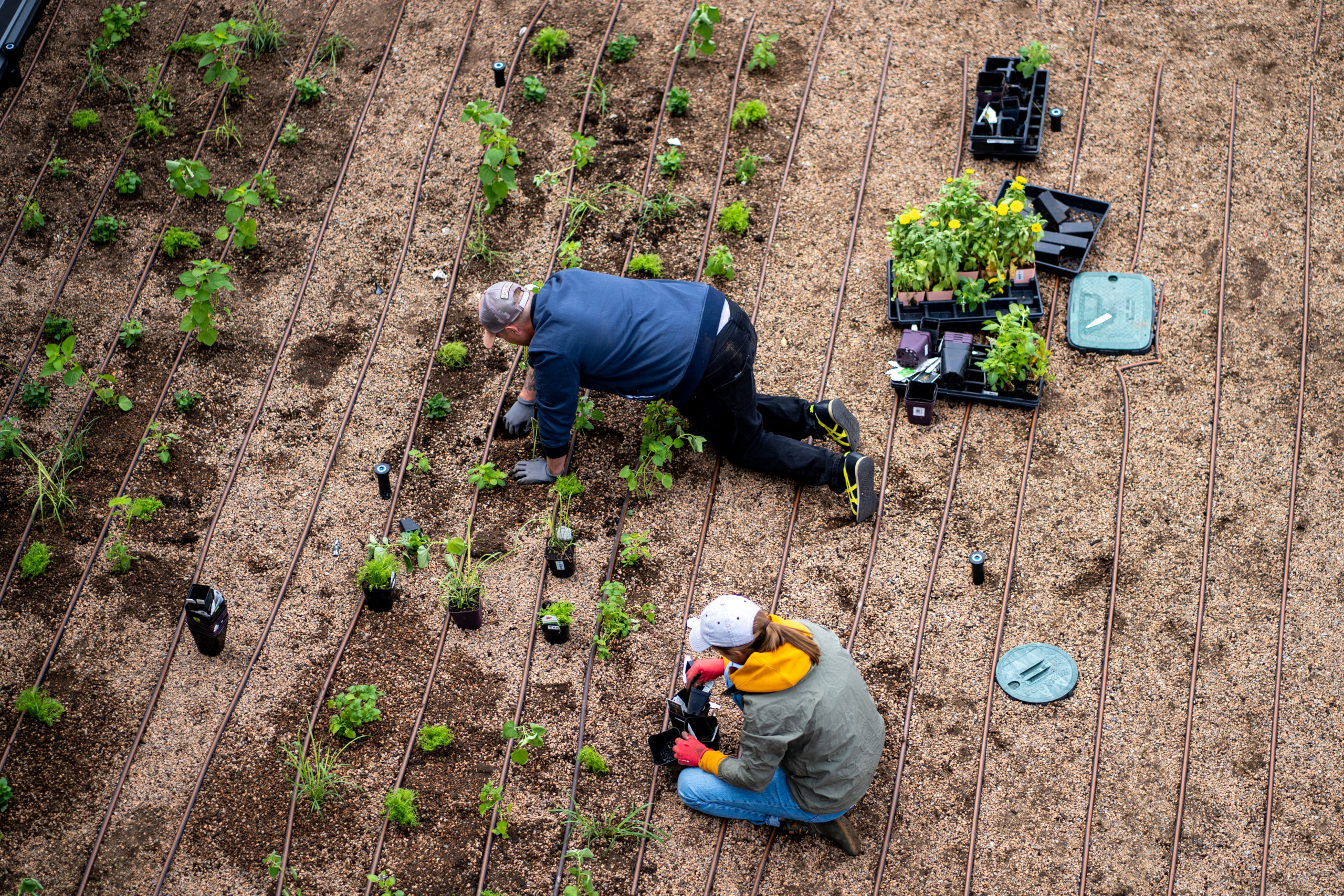With the opening of two new research green roofs at CSU’s Spur Campus in Denver – on the Terra and Hydro buildings – Jennifer Bousselot, Ph.D, assistant professor at CSU is thrilled.
She is passionate about horticulture and her primary research interest is green roofs, including green roof photovoltaics.

Let the planting begin
The Terra building opened in June and Bousselot, lead designer of the research green roof, began planting numerous crops – with help from many others – in the 576-square-foot food production area. Two of her graduate students and four CSU summer interns took on much of the maintenance work.
By the end of August, the plot had yielded 350-plus pounds of food, most of which went to local families in the food access program.
When NewsLeaf talked with Bousselot in September, she was in the Terra roof garden. “I see a hover fly on the cherry tomato plant. I’ve never seen one so big!” Obviously, the roof garden’s growing season is not yet over, and pollinators are still doing their job.
Terra and the entire Spur complex is designed for public interaction. Bousselot says the Terra rooftop garden is the largest publicly accessible green roof research space she knows of.



Green roofs and food security
“Green roofs are key to food security,” she believes. “The capacity is enormous.”
As a technical adviser for the green roof ordinance for the City and County of Denver that went into effect about five years ago, Bousselot’s rough analysis of green roof capacity suggested available space on low slope and flat roofs was about 5,000 acres. Using only 20% of that space – 1,000 acres – for food production, with a modest yield of 5,000 pounds per acre, could yield 5M pounds of food in just the City and County of Denver. She believes the future of food depends on using additional urban spaces where agriculture can exist – roofs!
There’s more. Bousselot’s research findings in a study she did several years ago – at the green roof located at the EPA office in Denver – showed that the presence of solar panels on the roof keeps plants cooler in the summer, warmer in the winter, reduces wind exposure and also reduces the total amount of daily sunlight. “The plants thrived with shade produced by the panels,” she says. “Yet we also found that the presence of the plants benefited the panels.”
According to Bousselot, solar panels – also called photovoltaics – operate most efficiently at 72oF. Rooftops can reach 170o. Plants respond to higher temperatures by evaporatively cooling the air around them, allowing the solar panels to cool and therefore be more efficient.
Hydro building green roof research is key
It’s the photovoltaics that most excite Bousselot about the opening of the Hydro building. She says the Terra building green roof will serve as the “control” research green roof, and the soon-to-open Hydro building green roof – in January 2023 – is designed for researchers to learn more about the synergistic benefits of pairing solar panels with green roof plants. Starting at the same time in spring 2023, an identical palette of plants will be planted on both the Terra and Hydro green roofs.
“The 3,000-square-foot green roof garden at the Hydro building will be the largest ‘rooftop agrivoltaics’ application in world right now, to our knowledge,” Bousselot says. “But we expect that to change soon.” Researchers are starting to pay attention to the benefits of rooftop agrivoltaics, which refers to the combination of rooftop agriculture with photovoltaics or solar panels.
“I’m a farm kid and what I love about agrivoltaics is it’s a way to farm in the city using the most cutting-edge systems. I think plants and photovoltaics may help extend the growing season,” Bousselot says. She is also wondering if she can get funding to plant fruit shrubs on Hydro. “With the panels, we can easily net around the fruit to protect it from birds, and maybe urban farmers could make some good income. Yes, I know some people may look at me sideways when I suggest this.”
Bousselot has funding for at least two studies right now. One is a leafy green trial that one of her graduate students is working on. The other will be for medicinal plants, which have more biomass. Holy basil, which thrived on Terra and became a shrub, and lemon grass and others, are tropical or subtropical and don’t mind heat. “With their large biomass, we hope to see more synergy between plants and the panels.”
“I’m really excited to try semi-transparent solar panels, which allow adequate light through the panels like a greenhouse,” she says. “It’s akin to biomimicry. Plants usually evolve within canopy layers that vary in light. But in this case, we’re growing plants under solar panels rather than under tree canopies.”


Green roofs benefits
Bousselot doesn’t think green roofs are going away. It’s not a fad. She points to Europe and some big American cities such as Portland and Chicago that already have millions of square feet of green roofs. Cities are realizing many of the environmental benefits such as improved stormwater management and reduced utility bills for heating and cooling, as well as help with heat island mitigation and with improving air quality.
Additionally, when it comes to water use for green roofs, according to Denver Water the impact is minimal – 1% of Denver Water’s usage at peak water demand (summer) for 1,000 acres of green roof space. It takes a huge number of green roofs to reach 1,000 acres.
Next gen children are learning now
“What’s so exciting to me every day I’m at Terra is seeing children with their mouths open in amazement. Hopefully they will grow up thinking ‘this is how it should be,’ and they’re going to ask for it,” Bousselot surmises. “That’s what’s going to make the change going forward.”
Bousselot is also reaching high school students. She currently co-teaches CSU’s Hort 100 to students in their junior or senior year at Bruce Randolph High School in Denver. Though lectures and quizzes are online, the high school students do the labs hands-on in the classroom. The school pays for the course making it free to the students, who get both high school and college credit. This opportunity provides students who pass the course with credits toward a college degree as a science course with a lab component, which hopefully encourages enrollment at CSU and more interest in science for the up-and-coming generation.











